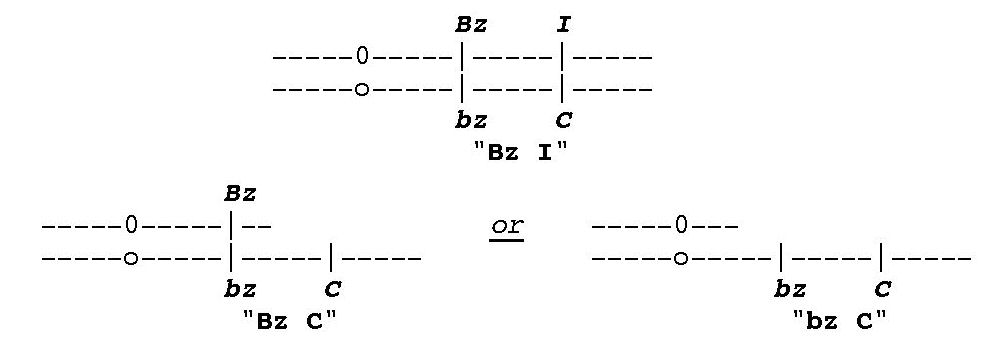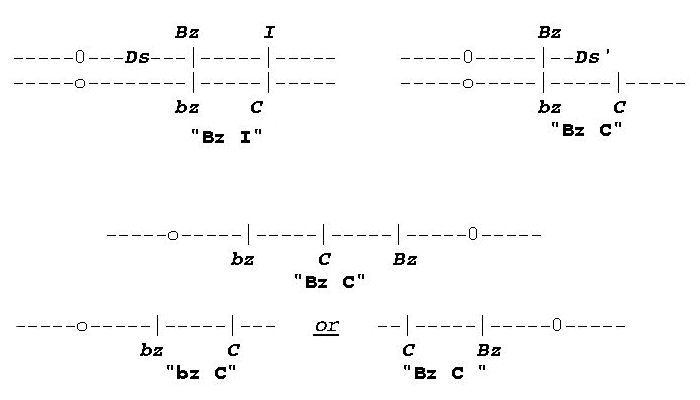
"Jumping Genes"
Classic genetic analysis of Maize phenotypes caused by the Ds (Dissociator) transposon element
C is the Color locus: the I (Inhibitor) allele is dominant to the wild-type C allele at the same locus , which produces purple pigment. [This could also be written as c+ or I+].
Bz is the Bronze locus: the bz allele produces a bronze color in the presence of C, and is recessive to wild-type Bz allele [bz+].
C is distal to Bz, closer to the Knob on the end of Chromosome 9., and can be broken off without removing the Bz.
Bz then being proximal to C , it cannot be broken off without removing C.
The genotype of the kernels shown in panels A–D is uniformly a trans double heterozygote, Bz I // bz C.
The expected phenotype is "colourless" ("I") due to the dominance of I to C, and Bz to bz.
Note that the "I" phenotypes in all six kernels are the same, and the differences in apparent color are a photographic artifact.
(A) The Bz I // bz C kernel shows the colorless "Bz I" phenotype. [Alternate chromosomes are shown with centromeres 0 and o].

(B) In the absence of the Ds (Dissociator) locus, random breakage of the 0 chromosome can results in loss of the I allele only [left], which uncovers fully-pigmented "Bz C" sectors, or both I and the more proximal Bz allele [right], which uncovers bronze-colored "bz C" sectors. The kernels are three-tone.

(C) In
the presence of the Ds
(Dissociator) locus,
non-random breakage of the 0 chromosome at that
locus proximal to the C and Bz
loci causes loss of both the I and
Bz alleles. This uncovers the C and
bz alleles on the other (o)
chromosome. The original colorless ("Bz I") sectors
then alternate with bronze ( "bz C") sectors. Note
the colored wild-type "C" rims between
sectors. They result from complementation
between gene products in the wild-type C
allele in bz C tissue and the
wild-type Bz allele in adjacent Bz
I tissue. Mixing of products of the Bz
and C loci at the borders
between sectors produces a localized "Bz C"
phenotype.


In panels E & F, the genotype is C Ds // c Ds+, and the ground phenotype is purple ("C") is due to the C (colored) allele, which is dominant to c (colorless, written above as I ).
(E) Transposition of Ds proximal to the C allele disrupts the chromosome, which causes loss of the C allele, and produces multiple colorless patches of C → c variegation on the colored background.
(F) Transposition of Ds into the C allele disrupts its function, and creates an unstable mutation Cu and a colorless ground phenotype. The c → C variegation arises when Ds spontaneously transposes back out of Cu, which restores wild-type C function in multiple colored patches on the colorless background.
----------
These experiments made in the 1940s by Barbara McClintock are a superb example of Classical Genetics, based entirely on controlled crosses, cytological observation of changes in chromosome morphology, and insight as to their explanation of resulting phenotypes, without any knowledge of DNA. That genes on supposedly "static" chromosomes were actually mobile within and between chromosomes was regarded as heretical, and largely ignored and (or) unappreciated for decades. Only after demonstration that 'transposable elements' in DNA constitute a majority of genomes was McClintock awarded the Nobel Prize (1983).
NB: According to Nina Federoff (pers. comm. to SMC), "Kernel development basically starts with a colorless phenotype due to the presence of the gene-inactivating Ds insertion in the C locus. The fact that the purple spots are mostly small indicates that transposition out of the locus generally happens late in development. While reinsertion sites [of Ds] tend to be near the source locus, they’re not that near, so the probability of a Ds transposing back into the C locus during development of a single kernel is pretty small."